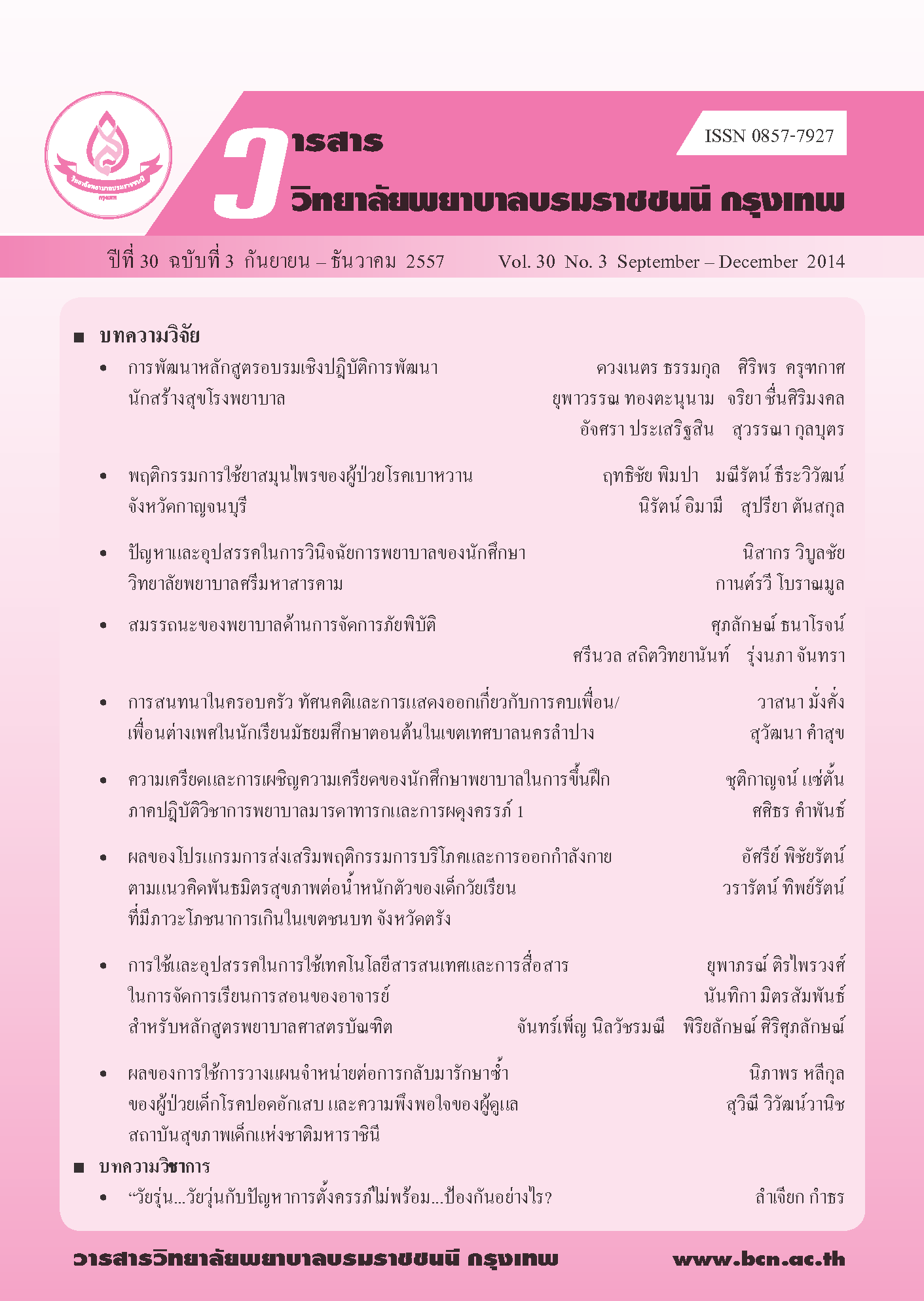พฤติกรรมการใช้ยาสมุนไพรของผู้ป่วยโรคเบาหวาน จังหวัดกาญจนบุรี HERBAL USING BEHAVIORS AMONG DIABETES, KANCHANABURI PROVINCE
คำสำคัญ:
การใช้สมุนไพร, ผู้ป่วยโรคเบาหวาน, HERBAL USE, DIABETIC PATIENTSบทคัดย่อ
บทคัดย่อ
พฤติกรรมการใช้ยาสมุนไพรในผู้ป่วยโรคเบาหวานเป็นพฤติกรรมที่พบได้บ่อย ที่สำคัญคือการเลือกใช้ยาสมุนไพรโดยไม่ได้รับคำแนะนำจากแพทย์หรือผู้เชี่ยวชาญโดยตรง ส่งผลต่อสุขภาพผู้ป่วยและอาจก่อให้เกิดภาวะแทรกซ้อนเป็นอันตรายต่อชีวิตได้ การวิจัยเชิงสำรวจภาคตัดขวางนี้ มีวัตถุประสงค์เพื่อศึกษาปัจจัยที่มีความสัมพันธ์กับพฤติกรรมการใช้ยาสมุนไพรของผู้ป่วยโรคเบาหวานชนิดที่ 2 จังหวัดกาญจนบุรี กลุ่มตัวอย่างใช้วิธีการสุ่มตัวอย่างอย่างง่ายโดยสุ่มจากทะเบียนรายชื่อผู้ป่วยโรคเบาหวานที่มารับบริการที่โรงพยาบาลพหลพลพยุหเสนาและยินยอมเข้าร่วมโครงการวิจัย ได้จำนวนตัวอย่าง 331 คน เก็บข้อมูลโดยการสัมภาษณ์ตามแบบสัมภาษณ์ที่ผ่านการตรวจสอบคุณภาพตามเกณฑ์ที่กำหนด วิเคราะห์ข้อมูลโดยใช้สถิติเชิงพรรณาได้แก่ ความถี่ ร้อยละ ค่าเฉลี่ย ส่วนเบี่ยงเบนมาตรฐาน และสถิติเชิงอนุมาน ได้แก่ การทดสอบไคสแควร์ (Chi-Square test)
ผลการศึกษาพบว่า กลุ่มตัวอย่างเป็นเพศหญิงร้อยละ 61 เพศชายร้อยละ 39 ระยะเวลาการป่วยเป็นโรคเบาหวานเฉลี่ย 9.51 ปี มีพฤติกรรมการรับประทานยาสมุนไพรร่วมกับยาที่โรงพยาบาลจัดให้ ร้อยละ 42 ปัจจัยด้านคุณลักษณะทางประชากรและสังคม พบว่า เพศ อายุ สถานภาพสมรส ระดับการศึกษา อาชีพ และรายได้เฉลี่ยต่อเดือน ไม่มีความสัมพันธ์กับพฤติกรรมการใช้ยาสมุนไพรของผู้ป่วยโรคเบาหวาน
(p-value>0.05) ปัจจัยด้านความรู้และความเชื่อ พบว่า มีเพียงความเชื่อในการใช้ยาสมุนไพรลดน้ำตาลในเลือดที่มีความสัมพันธ์กับพฤติกรรมการใช้ยาสมุนไพรของผู้ป่วยโรคเบาหวาน อย่างมีนัยสำคัญทางสถิติ
(p-value<0.05) และปัจจัยสนับสนุน พบว่า ระยะเวลาที่ป่วยเป็นโรคเบาหวาน การได้รับข้อมูลข่าวสารเกี่ยวกับยาสมุนไพรจากสื่อต่างๆ และประสบการณ์การใช้ยาสมุนไพรรักษาโรคอื่นๆ ไม่มีความสัมพันธ์กับพฤติกรรมการใช้ยาสมุนไพรของผู้ป่วยโรคเบาหวาน (p-value>0.05) ข้อเสนอแนะ โรงพยาบาลควรมีการส่งเสริมความรู้เรื่องการใช้ยาสมุนไพรให้แก่ผู้ป่วยโรคเบาหวาน เพื่อให้ผู้ป่วยมีความรู้และทักษะในการใช้ยาสมุนไพรที่ถูกต้อง
ABSTRACT
Herbal usage behavior among diabetic patients was often found and the related issue regarding usage of herbs without any direct suggestions from medical doctors or herbal experts. Herbal usage behavior had created some negative effects for diabetic patients and may cause complications, including fatalities. This cross-sectional survey research was aimed to investigate the factors related to herbal use among patients with Type 2 diabetes in Kanchanaburi Province. The populations consisted of three hundred and thirty-one patients were randomly selected from the hospital’s patient records. These individuals were those who received medical services at Phaholpolpayuhasaena Hospital, Kanchanaburi Province. All patients in the sample were willing to join the research project. Data collection was made by using a set of the interviewing schedules that was developed through the standard construction process. Data analysis was done by computing descriptive statistics which included frequency, percentage, mean, and standard deviation. Inferential statistics was also used to determine Chi-square.
The following research results were found: 61 percent of the samples were females while 39 percent were males; the average year of having diabetes was 9.51; 42 percent used herbs along with the medicines provided by the hospital; in regard to socio-demographic characteristics, there was no significant relationship between the samples herbal use and sex, age, marital status, occupation, and average monthly income (p-value>0.05); for knowledge and belief, the belief that “Herbs can lower blood sugar level” was found to be related significantly with herbal using behavior (p-value<0.05); and relating to reinforcing factors, there was no significant relationship between herbal use and the following factors: “Duration of having diabetes”; “Receiving information about herbs from various media”; and “Experiences of using herbals for curing other illnesses” (p-value>0.05) Thus, the suggestion was that the hospital should enhance diabetic patients knowledge regarding herbal usage in order to help patients gain a better understanding and improved skills levels about herbal use.
Downloads
ดาวน์โหลด
เผยแพร่แล้ว
รูปแบบการอ้างอิง
ฉบับ
ประเภทบทความ
สัญญาอนุญาต
บทความที่ได้รับการตีพิมพ์ เป็นลิขสิทธิ์ของวารสารวิจัยสุขภาพและการพยาบาล (วิทยาลัยพยาบาลบรมราชชนนี กรุงเทพ) ไม่สามารถนำไปตีพิมพ์ซ้ำในวารสารฉบับอื่น


















